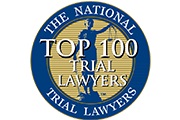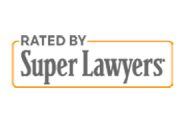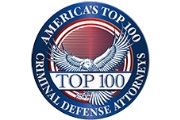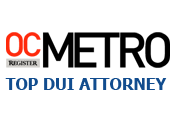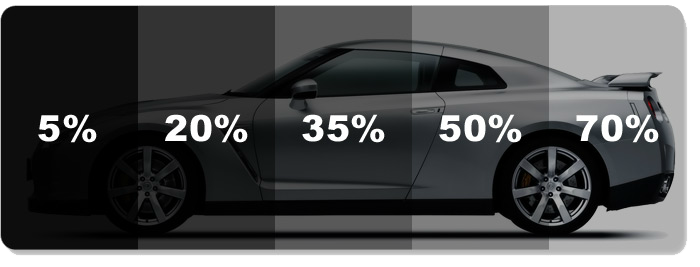ORANGE COUNTY'S "BEST" OR "TOP-RATED" DUI DEFENSE LAWYERS RATED BY SUPER LAWYERS, ORANGE COUNTY'S "TOP-RATED" DUI DEFENSE ATTORNEYS
Things to Know About Tinted Windows - CVC-26708 in California
CVC § 26708 - MATERIAL OBSTRUCTING OR REDUCING THE DRIVER'S VIEW; EXCEPTIONS, INSTALLATION, AFFIXATION OR APPLICATION OF TRANSPARENT MATERIAL
(a)(1) A person shall not drive any motor vehicle with any object or material placed, displayed, installed, affixed, or applied upon the windshield or side or rear windows.
(2) A person shall not drive any motor vehicle with any object or material placed, displayed, installed, affixed, or applied in or upon the vehicle that obstructs or reduces the driver's clear view through the windshield or side windows.
(3) This subdivision applies to a person driving a motor vehicle with the driver's clear vision through the windshield, or side or rear windows, obstructed by snow or ice.
(b) This section does not apply to any of the following:
(1) Rearview mirrors.
(2) Adjustable nontransparent sunvisors that are mounted forward of the side windows and are not attached to the glass.
(3) Signs, stickers, or other materials that are displayed in a seven-inch square in the lower corner of the windshield farthest removed from the driver, signs, stickers, or other materials that are displayed in a seven-inch square in the lower corner of the rear window farthest removed from the driver, or signs, stickers, or other materials that are displayed in a five-inch square in the lower corner of the windshield nearest the driver.
(4) Side windows that are to the rear of the driver.
(5) Direction, destination, or terminus signs upon a passenger common carrier motor vehicle or a schoolbus, if those signs do not interfere with the driver's clear view of approaching traffic.
(6) Rear window wiper motor.
(7) Rear trunk lid handle or hinges.
(8) The rear window or windows, if the motor vehicle is equipped with outside mirrors on both the left- and right-hand sides of the vehicle that are so located as to reflect to the driver a view of the highway through each mirror for a distance of at least 200 feet to the rear of the vehicle.
(9) A clear, transparent lens affixed to the side window opposite the driver on a vehicle greater than 80 inches in width and that occupies an area not exceeding 50 square inches of the lowest corner toward the rear of that window and that provides the driver with a wide-angle view through the lens.
(10) Sun screening devices meeting the requirements of Section 26708.2 installed on the side windows on either side of the vehicle's front seat, if the driver or a passenger in the front seat has in his or her possession a letter or other document signed by a licensed physician and surgeon certifying that the person must be shaded from the sun due to a medical condition, or has in his or her possession a letter or other document signed by a licensed optometrist certifying that the person must be shaded from the sun due to a visual condition. The devices authorized by this paragraph shall not be used during darkness.
(11) An electronic communication device affixed to the center uppermost portion of the interior of a windshield within an area that is not greater than five inches square, if the device provides either of the following:
(A) The capability for enforcement facilities of the Department of the California Highway Patrol to communicate with a vehicle equipped with the device.
(B) The capability for electronic toll and traffic management on public or private roads or facilities.
(12) A portable Global Positioning System (GPS), which may be mounted in a seven-inch square in the lower corner of the windshield farthest removed from the driver or in a five-inch square in the lower corner of the windshield nearest to the driver and outside of an airbag deployment zone, if the system is used only for door-to-door navigation while the motor vehicle is being operated.
(13)(A) A video event recorder with the capability of monitoring driver performance to improve driver safety, which may be mounted in a seven-inch square in the lower corner of the windshield farthest removed from the driver, in a five-inch square in the lower corner of the windshield nearest to the driver and outside of an airbag deployment zone, or in a five-inch square mounted to the center uppermost portion of the interior of the windshield. As used in this section, “video event recorder” means a video recorder that continuously records in a digital loop, recording audio, video, and G-force levels, but saves video only when triggered by an unusual motion or crash or when operated by the driver to monitor driver performance.
(B) A vehicle equipped with a video event recorder shall have a notice posted in a visible location which states that a passenger's conversation may be recorded.
(C) Video event recorders shall store no more than 30 seconds before and after a triggering event.
(D) The registered owner or lessee of the vehicle may disable the device.
(E) The data recorded to the device is the property of the registered owner or lessee of the vehicle.
(F) When a person is driving for hire as an employee in a vehicle with a video event recorder, the person's employer shall provide unedited copies of the recordings upon the request of the employee or the employee's representative. These copies shall be provided free of charge to the employee and within five days of the request.
(14)(A) A video event recorder in a commercial motor vehicle with the capability of monitoring driver performance to improve driver safety, which may be mounted no more than two inches below the upper edge of the area swept by the windshield wipers, and outside the driver's sight lines to the road and highway signs and signals. Subparagraphs (B) to (F), inclusive, of paragraph (13) apply to the exemption provided by this paragraph.
(B) Except as provided in subparagraph (C), subparagraph (A) shall become inoperative on the following dates, whichever date is later:
(i) The date that the Department of the California Highway Patrol determines is the expiration date of the exemption from the requirements of paragraph (1) of subdivision (e) of Section 393.60 of Title 49 of the Code of Federal Regulations, as renewed in the notice of the Federal Motor Carrier Safety Administration on pages 21791 and 21792 of Volume 76 of the Federal Register (April 18, 2011).
(ii) The date that the Department of the California Highway Patrol determines is the expiration date for a subsequent renewal of an exemption specified in clause (i).
(C) Notwithstanding subparagraph (B), subparagraph (A) shall become operative on the date that the Department of the California Highway Patrol determines is the effective date of regulations revising paragraph (1) of subdivision (e) of Section 393.60 of Title 49 of the Code of Federal Regulations to allow the placement of a video event recorder at the top of the windshield on a commercial motor vehicle.
(c) Notwithstanding subdivision (a), transparent material may be installed, affixed, or applied to the topmost portion of the windshield if the following conditions apply:
(1) The bottom edge of the material is at least 29 inches above the undepressed driver's seat when measured from a point five inches in front of the bottom of the backrest with the driver's seat in its rearmost and lowermost position with the vehicle on a level surface.
(2) The material is not red or amber in color.
(3) There is no opaque lettering on the material and any other lettering does not affect primary colors or distort vision through the windshield.
(4) The material does not reflect sunlight or headlight glare into the eyes of occupants of oncoming or following vehicles to any greater extent than the windshield without the material.
(d) Notwithstanding subdivision (a), clear, colorless, and transparent material may be installed, affixed, or applied to the front side windows, located to the immediate left and right of the front seat if the following conditions are met:
(1) The material has a minimum visible light transmittance of 88 percent.
(2) The window glazing with the material applied meets all requirements of Federal Motor Vehicle Safety Standard No. 205 (49 C.F.R. 571.205), including the specified minimum light transmittance of 70 percent and the abrasion resistance of AS-14 glazing, as specified in that federal standard.
(3) The material is designed and manufactured to enhance the ability of the existing window glass to block the sun's harmful ultraviolet A rays.
(4) The driver has in his or her possession, or within the vehicle, a certificate signed by the installing company certifying that the windows with the material installed meet the requirements of this subdivision and the certificate identifies the installing company and the material's manufacturer by full name and street address, or, if the material was installed by the vehicle owner, a certificate signed by the material's manufacturer certifying that the windows with the material installed according to manufacturer's instructions meet the requirements of this subdivision and the certificate identifies the material's manufacturer by full name and street address.
(5) If the material described in this subdivision tears or bubbles, or is otherwise worn to prohibit clear vision, it shall be removed or replaced.
Orange County DUI Attorneys Providing DUI Defense in Orange County - Laguna Hills, Laguna Beach, Orange
CALL NOW!
FREE CONSULTATION: (949) 235-2250
